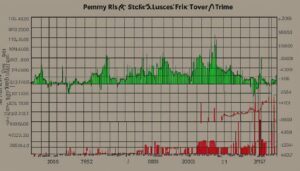In the world of investing, penny stocks offer a unique opportunity for high-risk, high-reward trading. These low-priced stocks can be incredibly volatile, presenting both challenges and potential for substantial gains. If you are willing to navigate the risks, there are proven strategies that can help you find success in trading penny stocks.
As a seasoned trader with extensive experience in the penny stock market, I will share valuable strategies that can increase your chances of making consistent gains. By implementing these strategies, you can unlock your potential for high-risk trading success.
Key Takeaways:
- Understand the risks associated with penny stocks before diving into trading.
- Conduct thorough research and perform fundamental analysis to make informed investment decisions.
- Implement technical analysis techniques for identifying potential entry and exit points.
- Manage risk through proper risk management strategies, such as setting stop-loss orders.
- Diversify your portfolio to spread the risk associated with penny stocks.
Understanding Penny Stocks and Their Risks
Before delving into strategies, it is important to have a clear understanding of penny stocks and the associated risks. Penny stocks are typically low-priced stocks with a market capitalization of under $5 per share. These stocks often trade on small exchanges and are considered highly speculative and volatile. The lack of liquidity and limited information available can make penny stocks particularly risky. It is crucial to conduct thorough research and exercise caution when investing in penny stocks.
Penny stocks may seem enticing due to their low share prices, but the reality is that they come with a higher level of risk compared to more established stocks. The stock price of penny stocks can be highly influenced by market manipulation and can experience extreme price fluctuations in response to even minor news or events.
Investing in penny stocks requires a deep understanding of the underlying company, its financial health, industry trends, and the overall market conditions. Without proper research and analysis, it is easy to fall victim to scams, pump-and-dump schemes, or companies with little to no potential for growth.
Due to their speculative nature, penny stocks should only be a small portion of a well-diversified investment portfolio. Investing a significant portion of your funds in penny stocks can expose you to undue risk, and it is essential to balance your risk exposure with more stable investments.
Now that we have a clear understanding of penny stocks and their risks, let’s move on to the strategies that can help you navigate this high-risk trading world and increase your chances of success.
Conducting Fundamental Analysis
When it comes to trading penny stocks, one of the fundamental strategies for success is conducting thorough fundamental analysis. This involves conducting research and gathering key information about the penny stock company to make well-informed investment decisions. By examining the company’s financial health, management team, industry trends, and competitive landscape, you can gain valuable insights into its potential and assess its viability as an investment option.
Start by examining the company’s financials, including its revenue, profitability, and debt levels. Look for companies with solid financial fundamentals and a history of consistent performance. This information can give you an indication of the company’s stability and growth potential.
Another important aspect to consider is the quality of the company’s management team. Research the backgrounds and experience of key executives to gauge their ability to navigate challenges and drive the company’s success. A strong leadership team is often a positive indicator for a penny stock’s potential.
Industry trends play a crucial role in the success of a penny stock company. Analyze the current state and future outlook of the industry in which the company operates. Look for growth prospects, emerging technologies or markets, and any regulatory factors that may impact the company’s operations. A company operating in a growing and promising industry stands a higher chance of success.
Competitive analysis is also vital in fundamental analysis. Identify the company’s competitors and assess their strengths and weaknesses. Look for any distinctive advantages that the penny stock company has over its competitors, such as unique products, patents, or market positioning. A company with a competitive advantage is more likely to thrive in its industry.
To stay updated on the latest developments related to the penny stock company, regularly monitor company news, earnings reports, and regulatory filings. This information can provide insights into any significant events or announcements that may impact the stock’s price or future prospects. By staying informed, you can spot potential opportunities or react to any warning signs.
Remember, conducting fundamental analysis is an ongoing process that requires diligence and continuous research. It is advisable to consult with financial professionals and leverage reputable sources of information to enhance your analysis.
// Inserted image
Implementing Technical Analysis Techniques
Technical analysis is a crucial tool for traders looking to excel in the world of penny stocks. By studying historical price patterns, trends, and indicators, you can gain valuable insights that help identify potential entry and exit points in the market.
When conducting technical analysis, it is essential to focus on chart patterns, which provide visual representations of a stock’s price movement over time. By recognizing these patterns, you can gauge the behavior of penny stocks and make more informed trading decisions.
Chart patterns like breakouts and reversals are frequently observed in penny stock trading. Breakouts occur when a stock price moves above a resistance level, indicating a potential upward trend. On the other hand, reversals signify a change in direction, indicating that a stock that has been declining may reverse its course and start moving upward.
Support and resistance levels also play a significant role in technical analysis for penny stocks. Support levels act as a floor for stock prices, preventing them from dropping further. Resistance levels, conversely, act as a ceiling, preventing prices from rising. By identifying these levels, you can make more accurate predictions about the future movement of a penny stock.
Moving averages are another important tool in technical analysis. These indicators smooth out the fluctuations in a stock’s price and help identify its underlying trend. Moving averages can be calculated over different timeframes, such as the 20-day moving average or the 50-day moving average. By analyzing the relationship between a stock’s price and its moving averages, you can identify potential buying or selling opportunities.
As technical analysis involves interpreting charts and patterns, it’s essential to use the right tools for analysis. There are numerous charting platforms and software available that provide advanced technical analysis capabilities. These tools allow you to overlay various indicators, draw trendlines, and perform complex calculations to enhance your decision-making process.
By combining technical analysis techniques with other strategies, such as fundamental analysis, you can strengthen your overall trading approach and increase your chances of success in penny stock trading.
Managing Risk and Building a Diversified Portfolio
When it comes to trading penny stocks, proper risk management is crucial for long-term success. As an investor, it is vital to never invest more than you can afford to lose. Penny stocks are highly volatile and can experience sudden price fluctuations, so it’s important to set realistic expectations and allocate your funds wisely.
One effective risk management strategy is to implement stop-loss orders. These orders automatically sell your shares if they reach a predetermined price, helping you mitigate potential losses. By setting stop-loss orders, you can protect your capital and avoid drastic financial setbacks.
Diversification is another key element in managing risk. Instead of putting all your eggs in one basket, consider building a diversified portfolio that includes a mix of penny stocks from different industries and asset classes. By spreading your investments across multiple stocks, you can reduce the impact of any single stock’s performance on your overall portfolio.
Regularly reviewing and adjusting your portfolio is essential for effective risk management. As the market conditions change, it’s crucial to reassess your investments and make necessary adjustments. By staying proactive and monitoring your portfolio regularly, you can ensure that your risk exposure remains within your desired parameters and maximize your potential returns.
FAQ
What are penny stocks?
Penny stocks are low-priced stocks with a market capitalization of under $5 per share. They are considered highly speculative and volatile, often trading on small exchanges.
Why are penny stocks risky?
Penny stocks are risky due to their lack of liquidity and limited available information. They can experience significant price fluctuations and carry a higher potential for fraud and manipulation.
How can I conduct fundamental analysis for penny stocks?
Conducting fundamental analysis involves researching the financial health, management team, industry trends, and competitive landscape of the penny stock company. This research helps make more informed investment decisions.
What is technical analysis for penny stocks?
Technical analysis involves studying historical price patterns, trends, and indicators to identify potential entry and exit points for trading penny stocks.
How can I manage risk when trading penny stocks?
It is important to never invest more than you can afford to lose and set stop-loss orders to mitigate potential losses. Diversifying your portfolio by investing in different industries and asset classes can also help manage risk.
Source Links
Disclaimer
All information on this website is of a general nature. The information is not adapted to conditions that are specific to your person or entity. The information provided can not be considered as personal, professional or legal advice or investment advice to the user.
This website and all information is intended for educational purposes only and does not give financial advice. Signal Mastermind Signals is not a service to provide legal and financial advice; any information provided here is only the personal opinion of the author (not advice or financial advice in any sense, and in the sense of any act, ordinance or law of any country) and must not be used for financial activities. Signal Mastermind Signals does not offer, operate or provide financial, brokerage, commercial or investment services and is not a financial advisor. Rather, Signal Mastermind Signals is an educational site and a platform for exchanging Forex information. Whenever information is disclosed, whether express or implied, about profit or revenue, it is not a guarantee. No method or trading system ensures that it will generate a profit, so always remember that trade can lead to a loss. Trading responsibility, whether resulting in profits or losses, is yours and you must agree not to hold Signal Mastermind Signals or other information providers that are responsible in any way whatsoever. The use of the system means that the user accepts Disclaimer and Terms of Use.
Signal Mastermind Signals is not represented as a registered investment consultant or brokerage dealer nor offers to buy or sell any of the financial instruments mentioned in the service offered.
While Signal Mastermind Signals believes that the content provided is accurate, there are no explicit or implied warranties of accuracy. The information provided is believed to be reliable; Signal Mastermind Signals does not guarantee the accuracy or completeness of the information provided. Third parties refer to Signal Mastermind Signals to provide technology and information if a third party fails, and then there is a risk that the information may be delayed or not delivered at all.
All information and comments contained on this website, including but not limited to, opinions, analyzes, news, prices, research, and general, do not constitute investment advice or an invitation to buy or sell any type of instrument. Signal Mastermind Signals assumes no responsibility for any loss or damage that may result, directly or indirectly, from the use or dependence on such information.
All information contained on this web site is a personal opinion or belief of the author. None of these data is a recommendation or financial advice in any sense, also within the meaning of any commercial act or law. Writers, publishers and affiliates of Signal Mastermind Signals are not responsible for your trading in any way.
The information and opinions contained in the site are provided for information only and for educational reasons, should never be considered as direct or indirect advice to open a trading account and / or invest money in Forex trading with any Forex company . Signal Mastermind Signals assumes no responsibility for any decisions taken by the user to create a merchant account with any of the brokers listed on this website. Anyone who decides to set up a trading account or use the services, free of charge or paid, to any of the Broker companies mentioned on this website, bears full responsibility for their actions.
Any institution that offers a service and is listed on this website, including forex brokers, financial companies and other institutions, is present only for informational purposes. All ratings, ratings, banners, reviews, or other information found for any of the above-mentioned institutions are provided in a strictly objective manner and according to the best possible reflection of the materials on the official website of the company.
Forex/CFD trading is potentially high risk and may not be suitable for all investors. The high level of leverage can work both for and against traders. Before each Forex/CFD investment, you should carefully consider your goals, past experience and risk level. The opinions and data contained on this site should not be considered as suggestions or advice for the sale or purchase of currency or other instruments. Past results do not show or guarantee future results.
Neither Signal Mastermind Signals nor its affiliates ensure the accuracy of the content provided on this Site. You explicitly agree that viewing, visiting or using this website is at your own risk.




